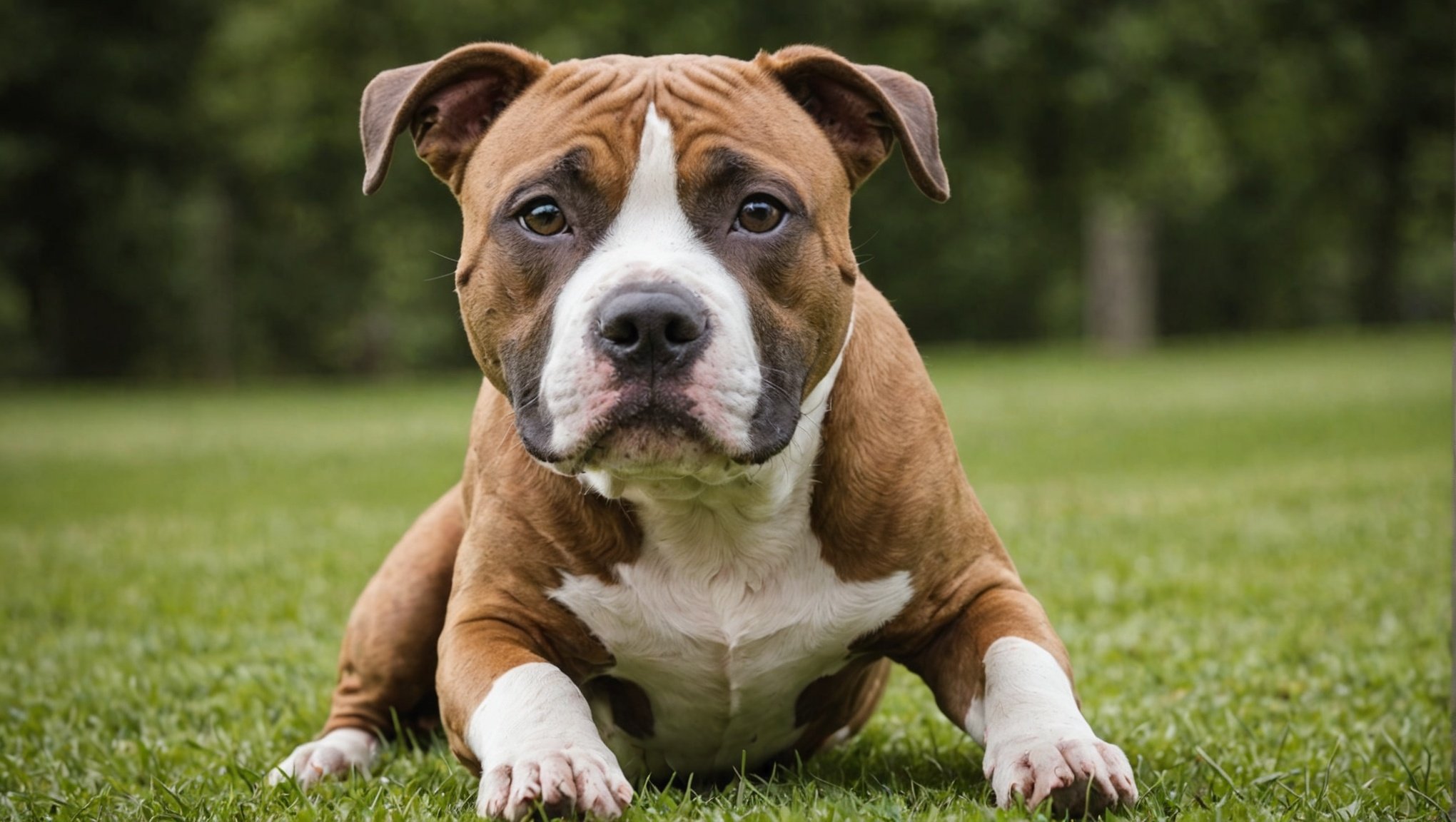American Staffordshire Terriers bring joy and energy into our lives, but their enthusiastic play can sometimes become overwhelming. If you’ve found your pup’s roughhousing challenging, you’re not alone. Many owners grapple with balancing their dog’s spirited nature while fostering gentle interactions. This guide offers practical strategies tailored to transform your American Staffordshire Terrier’s play style, creating a harmonious atmosphere for both you and your furry friend. Get ready to cultivate a more enjoyable and safe play experience!
Understanding the American Staffordshire Terrier’s Play Behavior
The American Staffordshire Terrier is known for its energetic and enthusiastic play style. Their natural play tendencies often involve physicality and exuberance, reflecting their strong and muscular build. This breed’s play behavior is characterized by a mix of rough play and gentler interactions, which can sometimes be misunderstood.
A lire en complément : Maximizing Exercise for Your Whippet: Creative Solutions for Small Spaces
Overview of Play Tendencies
American Staffordshire Terriers engage in play that can appear intense. It’s crucial to differentiate between rough play and aggression. Rough play may involve play-bowing, chasing, and gentle mouthing, all of which are normal for this breed. These behaviors are part of their socialization and exercise needs.
Identifying Signs of Rough Play vs. Normal Play
To discern between rough play and potentially problematic behavior, observe the dog’s body language. Signs of normal play include relaxed postures, wagging tails, and mutual engagement with playmates. If you notice stiff body language or growling, it may be time to intervene.
A lire aussi : Is It Possible to Train a Scottish Terrier to Coexist Peacefully with Small Animals Like Hamsters?
The Role of Breed Characteristics
The American Staffordshire Terrier’s behavior is heavily influenced by its breed characteristics. Their play style is often vigorous due to their history as working dogs. Understanding these traits helps in providing appropriate outlets for their energy, ensuring a happy and well-adjusted pet.
Importance of Socialization in Reducing Rough Play
Understanding the significance of dog socialization is crucial in managing the play behavior of American Staffordshire Terriers. Early puppy socialization plays a pivotal role in shaping a dog’s behavior, reducing the likelihood of rough play escalating into unwanted aggression. Exposing puppies to various environments, people, and other animals helps them develop a well-rounded temperament.
Techniques for Effective Socialization
Implementing effective socialization techniques is essential. Begin by introducing your puppy to different settings, such as parks or pet-friendly stores, where they can interact safely with other dogs and humans. Controlled playdates with well-behaved dogs can be beneficial, allowing your puppy to learn appropriate play boundaries.
Incorporate positive reinforcement when your dog exhibits desired behaviors during these interactions. This can include treats, praise, or playtime, reinforcing positive associations with social experiences.
Benefits of Diverse Exposure
The benefits of exposure to various environments and animals are manifold. It not only aids in behavioral modification but also boosts the dog’s confidence and adaptability. A well-socialized American Staffordshire Terrier is less likely to resort to rough play as a means of communication, leading to a more harmonious coexistence with other pets and humans.
Effective Training Strategies for Gentle Interactions
Training your American Staffordshire Terrier to engage in gentle interactions requires a combination of effective dog training techniques and a commitment to positive reinforcement. These strategies not only enhance your dog’s behaviour but also strengthen the bond between you and your pet.
Overview of Positive Reinforcement Training
Positive reinforcement is a training method that rewards desired behaviours, encouraging your dog to repeat them. When your dog plays gently, immediately reward them with treats, praise, or playtime. This creates a positive association with gentle play, making it more likely to occur in the future.
Specific Commands to Teach for Gentler Play
Incorporating specific commands such as “gentle,” “easy,” or “settle” can be effective in moderating play behaviour. Start by using these commands during controlled play sessions. When your dog responds appropriately, reinforce the behaviour with a reward. Over time, your dog will learn to associate these commands with reducing play intensity.
Creating a Consistent Training Schedule and Environment
Consistency is key in any training regimen. Establish a regular training schedule and maintain a calm, distraction-free environment. Consistent training helps your dog understand expectations and fosters a sense of security. By sticking to a routine, your American Staffordshire Terrier will become more adept at engaging in gentle interactions.
Behavioral Analysis: Understanding Triggers for Rough Play
Understanding dog behavior analysis is essential for managing the play habits of American Staffordshire Terriers. Identifying play triggers that lead to rough play can help in preemptively addressing potential issues. Common triggers include unfamiliar environments, overstimulation, or the presence of new playmates. Recognizing these factors allows for timely intervention.
Analyzing Body Language and Vocalizations During Play
Observing behavioral cues such as body language and vocalizations provides insights into your dog’s play intentions. Relaxed postures, wagging tails, and playful barks typically signify normal play. However, if you notice stiff body movements, direct stares, or growling, these may indicate escalating roughness. By understanding these signals, you can better manage your dog’s interactions.
Strategies for Redirecting Rough Play Behaviors
To redirect rough play, employ strategies that focus on positive reinforcement and redirection. Introduce toys that can channel your dog’s energy into constructive activities. When your dog begins to play too roughly, redirect their attention to these toys or engage them in a different activity. Consistently rewarding gentle play with treats or praise reinforces the desired behavior. Over time, your American Staffordshire Terrier will learn to associate gentle play with positive outcomes, reducing the likelihood of rough interactions.
Activities to Promote Gentler Play
Engaging your American Staffordshire Terrier in dog play activities can significantly encourage gentle interactions. One effective approach is incorporating interactive games designed for safe play. Games like fetch or tug-of-war can be modified to emphasize gentleness by using softer toys and teaching the “drop” command to ensure controlled play sessions.
Incorporating Mental Stimulation Through Toys and Puzzles
Introducing toys and puzzles that stimulate your dog’s mind is another way to promote gentle play. Toys such as treat-dispensing balls or puzzle feeders challenge your dog mentally and provide an outlet for their energy. These activities not only entertain but also encourage your dog to focus on problem-solving rather than rough play.
The Importance of Supervised Play Dates with Other Dogs
Supervised play dates with well-behaved dogs offer a controlled environment for your dog to learn social cues and manage play intensity. During these sessions, monitor interactions closely to ensure behaviors remain safe and appropriate. This not only aids in reducing rough play but also enhances your dog’s social skills, fostering positive relationships with other dogs.
The Role of Owner Interaction in Modifying Play
Engaging with your American Staffordshire Terrier is crucial in shaping their play behavior. Owner engagement plays a significant role in influencing how your dog interacts during playtime. By actively participating and monitoring play sessions, you can guide your dog’s behavior effectively.
How Owner Behavior Influences Play Dynamics
Your dog training approach directly impacts play dynamics. Consistent and positive interactions encourage your dog to mirror your behavior. For instance, maintaining a calm demeanor during play can help your dog remain composed, reducing the likelihood of rough play. Effective communication, through verbal cues and body language, is essential in guiding your dog’s actions.
Techniques for Guiding Play Behavior During Interactions
Implementing structured play sessions is beneficial. Use effective communication techniques like clear commands and hand signals to direct your dog. When your dog exhibits desired play behavior, reward them promptly. This reinforces positive actions and encourages repetition.
The Significance of Setting Boundaries and Limits
Establishing boundaries is vital in managing play behavior. Clearly define what constitutes acceptable play and consistently enforce these limits. If your dog oversteps, redirect their attention and reinforce appropriate behavior. By setting firm boundaries, you create a safe and enjoyable play environment for both you and your pet.
Expert Tips on Maintaining a Safe Play Environment
Creating a safe play environment for your American Staffordshire Terrier is essential for ensuring their well-being and enjoyment during playtime. A well-prepared space minimizes risks and enhances dog safety.
Creating a Safe Space for Play
To establish a secure area, remove any hazardous objects and ensure the space is enclosed to prevent your dog from wandering into unsafe zones. Consider using soft, durable materials for toys and surfaces to cushion any falls or impacts during play.
Monitoring Playtime to Prevent Escalation
Playtime management is crucial in preventing rough play from escalating. Keep a watchful eye on your dog’s interactions, especially when playing with other dogs. Look for signs of overstimulation or fatigue, such as heavy panting or decreased responsiveness. Intervene promptly if play becomes too intense.
The Importance of Breaks and Downtime
Incorporating regular breaks during play sessions helps maintain dog safety and prevents exhaustion. Allow your dog to rest and hydrate, ensuring they remain calm and composed. Downtime also provides an opportunity to reinforce positive behaviour through gentle interaction and praise, promoting a balanced play routine.
Success Stories: Transforming Rough Play into Gentle Interactions
Transforming an American Staffordshire Terrier’s rough play into gentle interactions is not only possible but has been achieved by many dog owners. Through dog training success stories, we can see how consistent effort and the right techniques lead to positive outcomes.
Real-Life Examples of Transformed Behaviors
Consider the case of Max, a lively American Staffordshire Terrier, whose owners struggled with his intense play style. By implementing positive reinforcement and structured play sessions, Max’s behavior transformed over several months. His owners reported a significant reduction in rough play, with Max now engaging more gently with family members and other pets.
Analysis of Techniques Used in Successful Cases
Successful transformations often involve a combination of positive reinforcement and consistency. Training methods such as rewarding gentle behavior with treats or praise have proven effective. Additionally, using specific commands like “gentle” during play sessions helps reinforce desired behaviors. These techniques, when applied consistently, encourage dogs to adopt gentler interaction patterns.
Encouragement and Motivation for Owners Facing Challenges
For owners facing challenges with their dog’s play behavior, these case studies offer motivation. They demonstrate that with patience and the right approach, even the most energetic dogs can learn to play gently. Embrace the journey, and remember that every small success contributes to a harmonious relationship with your pet.
















